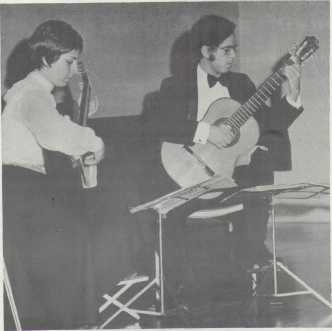
|
|
||
|
Creative Guitar International
Vol. 1, Number 1 Fall 1973 Single copy $2.50
|
||
|
|
||
 |
||
|
|
||
|
Photograph by Howard Cole COSTERO-BELTRÁN DUO AT CONCERT
|
||
|
|
||
|
|
||||||
|
creative guitar international
|
Vol. 1 |
contents
A new era of duo guitarists ?
A romantic Bach
Teaching problems: Parents
Contemporary concerto
Guitar with cello
A Hollywood
|
3 11
13
22
24
27 30
|
CREATIVE GUITAR INTERNATIONAL 3
A new era of duo guitarists?
A name that has steadily come to the forefront in the classic guitar world is that of Argentine Manuel Lopez Ramos. Lopez Ramos' increasing fame rests on his teachings, although he plays magnificently and has made recordings abroad and in the U.S. on the RCA label. The Lopez Ramos approach to the guitar is almost a way of life. He is an artist and a musician in a field where many professionals are merely guitarists. This artistry and musicianship reflects in his teaching, and subsequently, his students.
POSITIVE FORCE
Lopez Ramos is a positive force in a sea of negative attitudes about the guitar. He has strong opinions about the classic guitar--about a right hand position, the filing and care of nails, study materials, practice habits, even about smoking (he disapproves smoking by guitarists). To some, these opinions seem welcome in a field wrought with uncertainty and negativism at least in the Americas.
TRIBUTE TO LOPEZ RAMOS
A tribute to Lopez Ramos, then, is the young duo of Maricarmen Costero and Mario Beltrán, both teachers in the Lopez Ramos studio inMexicoCity. This duo has three times toured Europe, and recently made a recording on the Angel label (released at this writing only outside the U.S. Please see review, page 11).
|
||
|
© 1973 by Ruth and Jerry Mock. Creative Guitar International is a classic guitar magazine published three times a year in the fall, winter and spring by Mockingbird Press, Box 1275,
Edinburg, TX 78539.
|
||||||
|
Subscription rates $5 a year. composition
ASTA meeting
editor/publisher: Jerry Mock; contributing editors: pedagogy/Ruth Mock; research/Frank Wagner; photography/Howard Cole From our subscribers
|
||||||
|
"Creative Guitar International" received enthusiastic support before the first issue came off the press. A questionnaire was sent to a group of guitarists and interested persons asking their opinions about the type of stories they wanted in "Creative Guitar International. " The interesting results will be published in a subsequent issue. (If you receive a questionnaire please fill it out and return.) Here are some of the early comments:
"Ole to the Mock family! And more power to you," wrote Rina Bavresco, guitarist of Denver, CO.
"Anything by Maricarmen Costero and/or Mario Beltran has got to be great," wrote Sanford C. Frumker, (please turn to page 31)
|
||||||
|
|
||||||
|
|
|||
|
CREATIVE GUITAR INTERNATIONAL 4
Miss Costero and Beltrán, both under 30, industrious, ambitious, artistic, and well-trained, perhaps the avant garde of a new era of competent classic guitarist-musicians, already are veteran performers.
The duo toured Europe in 1969, 1970 and 1972, when, Miss Costero said in a recent interview in Mexico City, "we played in very important halls. We played in Berlin, Salzburg, Brussels, London, Amsterdam and in France.
PLAY THREE ENCORES
"The press received us well, but the audience received us beautifully. We never played three encores in our lives, but on that tour we did, almost all the concerts, because the audience was so warm with us."
The friendly critics and enthusiastic audiences of Europe do not guarantee the same in the United States, which is the next hurdle in the duo's climb to fame.
AUDIENCES COMPARED
Miss Costero compares the audiences in Europe and the Americas:
"The big difference is that when you put on a guitar concert in the United States or Mexico, 90 per cent of the audience is made up of people who play the guitar, even popular guitar, but they have some commitment to the guitar. You know the word Mafia? We call it the guitar Mafia: The main audience that is made up of people who play the guitar.
|
CREATIVE GUITAR INTERNATIONAL 5
"In Europe it is not that way. Of course many people play the guitar, but I would say that 30 per cent of the audience is made up of guitar players, and the other 70 per cent are people who like music, who go to hear music, not the guitar. I think we were so tremendously successful because we play the guitar musically. Nowadays, there are many good guitar players, but not all of them play musically.
COLD FOR ALL ARTS
"We think that music is the most important thing. It is not the instrument you are using. And we think that if, sometime in this life, we get to have a name, it will be because we knew music; I mean to play musically, not just to play notes. Nowadays people have become very cold for everything in all arts. I don't understand anything about painting, but you have seen modern painting, just a bunch of colors running up and down. The same thing happened with sculpture. Sometimes they just take anything and put it there and they say it is a piece of art. I just laugh, because I don't think that is art. Maybe we are from another century. We are out of this world, no? We think that beauty is art. And feeling is art. Like modern music, I mean, like electronic music and all that should not be called music. It has no rhythm, no harmony, no melody, no feeling. It is not an art. It is something else. Like many people say, it is interesting, but it is not art. There is a phrase by Ponce (Mexican composer Manuel Ponce), something like, 'if you create anything that's creative, if you don't put your soul into it, it won't be transmitted to others.'"
|
||
|
|
|||
|
|
|||
|
CREATIVE GUITAR INTERNATIONAL 6
Both Miss Costeroand Beltrán consider they started studying the classic guitar when they began at the Lopez Ramos studio in 1962, even though both had played previously. Beltrán, a gracious Mexican who speaks English but prefers Spanish, began playing popular music in his native Chihuahua; Miss Costero also played popular guitar before studying for one year at the conservatory.
DECIDE TO PERFORM PROFESSIONALLY
The duo met at the Lopez Ramos studio and played together in ensemble, which is part of the Lopez Ramos program. Beltrán began playing duos with Alfonso Moreno. When Moreno gained the finals of theConcours International de Guitare of Paris in 1968, he concentrated on solo practice. (Moreno became the first Mexican to win the coveted prize.) Beltrán and Miss Costero began practicing together and about a year later decided to perform together professionally.Beltrán followed Moreno to the Paris Concours and in 1969 was awarded First Accesit. It was during this first trip to Europe that Miss Costero and Beltrán also performed as a duo in concert halls.
WORRY MORE ABOUT MUSIC
When no concert is in sight, the duo practices together once a week. After working on a piece separately, they play it together.
"For some time," said Miss Costero, "we just play and try to get out the music from the piece. Once we
|
CREATIVE GUITAR INTERNATIONAL 7
know what we are going to do, musically speaking, with the piece, we practice by parts, with the metronome, slower at first, and then increasing our speed.
"We worry much more about the music when we practice together, than about the technique."
PLAY A PIECE TEN TIMES
When practicing for a concert, they play as if they were playing for an audience, without metronome, concentrating alternately on the various pieces of the program. One day they play one piece ten times, the others once (which takes about three hours), the next day they repeat another piece and play the others once, on through the program.
ALSO GIVE LESSONS
"When we go on a tour," said Miss Costero, "we practice every day. In our studio, we don't have much time, just the mornings to practice—we give lessons in the afternoon. So we have to spread our time in order to practice by ourselves separately. It is difficult to practice technically together, because many times I have a very easy part, and at exactly that moment, Mario has a very difficult part, then the opposite is true, so that is why it is so important to practice separately, so each one can practice more the difficult parts."
EXPLAINS PROBLEMS
Miss Costero explained some of the problems in performing as a duo: "When you go in a hall and you play, you do things once. You don't have two opportu-
|
||
|
|
|||
|
|
|||
|
CREATIVE GUITAR INTERNATIONAL 8
nities, or three. Like a painter: If he likes it, he shows it. But in a concert, you go out there and you play. And you do it once, and that's it. And many times it depends on your humor that day: How do you feel? How are your hands? How are your nails ? Actually, there are so many things that can make a slight difference, and that slight difference separates a wonderful concert from a good concert. When you have two people playing, you have to get that night in which both are in a good mood, with nails, fingers, everything warm and perfect. As you know, that situation is very difficult to put together for two people.
MUST SHARE MUSIC
"That's one of the problems. There are many other problems, of course. You have to depend on what the other is doing, musically speaking. You just can't do whatever you want, because you are not playing by yourself. You have to share the music, and that makes a lot of difference."
OWN ARRANGEMENTS
What music do they use ?
"It is not just one thing. We do our own arrangements. We use other arrangements that are published, like Zarate, the Argentine, and there are many things published. And also original music for guitar."
Do they use any of their own?
"Yes. Most of it is our own arrangements, say 70 per cent. We are trying to play more original music for
|
CREATIVE GUITAR INTERNATIONAL 9
two guitars. Even if there is not too much music for two guitars, and not too much good music for two guitars, we try to play music especially written for two guitars.
On the 1969 European tour the duo stopped off to play for the New York City guitar society.
WOULD TALK WELL OF IT
"I think they liked it very much," said Miss Costero, but they were not as warm as Europeans. Sometimes when people go to a concert, they expect something. When you go to a concert you expect something out of that concert. And if what you hear is different from what people are expecting, then your reaction is very slow. I'm sure that if somebody asked the people who went to that concert now they would talk very well of it. Of course, they expressed it during the concert also. They were very happy, etc., etc. , you know.
USED TO DIFFERENT GUITAR
"But people are used to a different guitar than what we play. So when they go to a concert they are expecting the usual guitar that they hear. And we start playing and it is a different thing. Most of the guitar players play just with the nails, no rest stroke, no vibrato, so the guitar sounds very much like the harpsichord. Some guitarists play very difficult things ina perfectway, technically speaking. I mean, all the notes in their places, but no music after that. People are used to that, especially the guitar,and we are not that kind of guitar players.
|
||
|
|
|||
|
|
||||
|
CREATIVE GUITAR INTERNATIONAL
|
10
|
CREATIVE GUITAR INTERNATIONAL 11
A romantic Bach
"French Suite No. 5" by J.S. Bach and "Children's Corner," by C.A. Debussy, by guitar duo Maricarmen Costero and Mario Beltrán. Angel SAM 35014.
Unfortunately, this record has been released at this writing, only outside the U.S.A.
AVERAGE RECORD
Whereas the average guitar record bears the name of at least half a dozen composers, this bears only one a side--Bach and Debussy.
Whereas the average classic guitar record displays technique at the expense of musicianship this record tends toward the opposite--musicianship above all. The piece is the thing. Bach was a baroque composer and the baroque age was a romantic age. The duo Costero-Beltrán perform Bach as a romantic, with sensitivity, even down to the ornaments, correctly played for the period, with trills lingering, exactly long enough.
TAPE OF EARLIER PERFORMANCE
By a coincidence, I possess a tape I made of a performance of the same Bach "French Suite" by Miss Costero and Beltrán in the summer of 1967 at the Lopez Ramos studio in Mexico City.
Differences in the record and tape are not astounding, even though at the time the tape was made they had studied
|
||
|
"That doesn't mean that we don't have a technique. Of course we do. But we use that technique for doing music, and not for showing off. What we try to do is to follow the Segovia tradition in playing. That doesn't mean that we want to play like he wants to play. But what we want to follow is the spirit. We have never been taught by Segovia directly, but we have been very much through his records and try to understand what he is doing."
|
||||
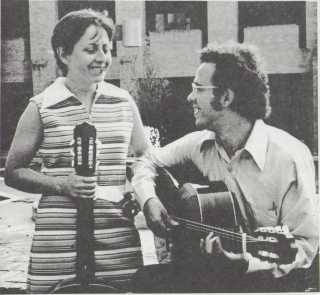 |
||||
|
costero-beltra'n DUO PRIOR TO JUNE CONCERT AT FINE ARTS COMPLEX, PAN AMERICAN UNIVERSITY, EDINBURG, TX.
|
||||
|
|
||||
|
|
||||
|
CREATIVE GUITAR INTERNATIONAL
|
12
|
CREATIVE GUITAR INTERNATIONAL 13
to describe musically snowdrops falling on the ground would be extremely high in a scale of the various instruments. The fact that the guitar is played by the fingers of the right hand give it the potential delicacy unsurpassed by the more conventional instruments such as the piano or violin. Miss Costero's rendition of the suite for guitars surely would have pleased Debussy.
NOTATION NOT AVAILABLE
It is rather unfortunate that her notation of the Debussy work is not available for purchase. Although a major music publishing house has shown interest in publishing her duo arrangement, her time in teaching and performing do not allow her to make it available in a form satisfactory to the publisher. Surely someone could be of assistance in this matter, for Miss Costero and Beltran thoroughly finger their music and either work would be an attractive package for the enjoyment of other duo guitarists.
BY JERRY MOCK
|
||
|
in the studio only five years. The differences are subtle:
The first movement begins slower, perhaps more lyrical,
and the last movement ends faster, on the record than in
the studio tape. Musically the
record seems superior (although)
it is somewhat unfair to compare
a low quality tape of a perform- REVlEWS
ance before some students with
a professionally made recording), not so much due to
improved technique as superior musicianship.
ROMANTIC BACH
The musical coordinator of the record is the teacher of Miss Costero and Beltrán, Manuel Lopez Ramos. Perhaps a tribute to him is that the duo sounds somewhat like two Lopez Ramoses, each interpreting his part. One can detect the Lopez Ramos touch throughout the duo--a lush sound and a romantic Bach is beautiful to hear, at least in this recording.
LITTLE OBJECTION
Both the Bach and the reverse side, Debussy's "Children's Corner" are transcriptions. The transcription of Bach should meet little objection, because interchange of instruments was a baroque custom. In fact, a case could be made that the guitar is a more appropriate instrument for Bach music than the piano. The Debussy makes me wonder if Debussy was really writing for two guitars rather than the piano, and only had not discovered the guitar's potential as an instrument for his impressionistic music. The guitar's potential for the shading needed
|
||||
|
Teaching problems: Parents
I was teaching a nine-year-old boy the accompaniment pattern to an Argentine folk song, when suddenly he stopped playing and asked: "Mrs. Mock, do you work?
I laughed and replied, "Well, I teach guitar if that is work."
Obviously he enjoyed the guitar and he knew that I did
|
||||
|
|
||||
|
|
|||||
|
CREATIVE GUITAR INTERNATIONAL
|
14
|
CREATIVE GUITAR INTERNATIONAL
|
15
|
||
|
|
|||||
|
too. But the father of an eight-year-old boy who had just learned his son was to begin guitar lessons had a different impression of the instrument: "Now son," he said, "I want you to know that this is going to be WORK and you won't have much time for play . "
After his first
lesson the sameChildren's corner
child' s mother
asked what to do if the boy wanted to practice all the time.
I replied, "Let him practice. "
Both of the children referred to above obviously had a healthy outlook toward studying guitar. If only all parents had the same healthy outlook.
SOME PARENTS IMPOSE PROBLEMS
Teaching children is fun. But some parents impose problems which need to be eliminated from the start. My first problem usually is that of parental attendance at lessons.
The phone rings with an inquiry about guitar lessons for a child. After a brief run-down of tuition and textbook fees, I explain how we play in the "classic guitar style." We read music, use nylon strings and play with the thumb (p), index (i), middle (m) and ring (a) fingers of the right hand. This discussion eliminates the would be "strummer" or the student who "just wants to learn a few chords."
Then I ask the parent if she would be willing to accompany her child (up to the age of 15!) to all lessons and agree to supervise, practice with him when necessary or
|
at least take an interest in the lessons assigned. Sometimes there is a long silence, then a sigh! This may be followed with the mother's reply, "I will have to discuss this with my husband and call you back." At times this stops further conversation because, unfortunately,some parents do not want to become involved.
NO KNOWLEDGE OF MUSIC
The parent may agree to come to the lessons, but may complain about having no knowledge of music. This is precisely the reason I want her there! Nine-year-olds have a lot of questions and need help. One ten-year-old's mother solved the problem by having an older student tutor her son twice a week. She did not want to sit with him. However, he continued lessons as long as he had a tutor and stopped when the tutoring stopped. On the other hand, another child who was 12 had a mother who was a pianist. We listened to her stories of "When I was young, I would sit for three hours by myself and no one had to help me...I just don't see why he won't practice by himself." This mother further kept her distance with her knitting needles during the boy's lessons. The boy lasted about eight months.
ATTENDANCE, INTEREST NEEDED
My students stay with their lessons as long as there is the attendance and active interest of the parent, usually the same parent. A ten-year-old's parents used to fight over which parent would take him to his lesson. The mother claimed the daddy should because he was more interested in the guitar. The daddy claimed the mother should because she could play the piano and knew more about music. The lessons ended with neither one bringing him. Sometimes a parent will delegate the authority to an
|
||||
|
|
|||||
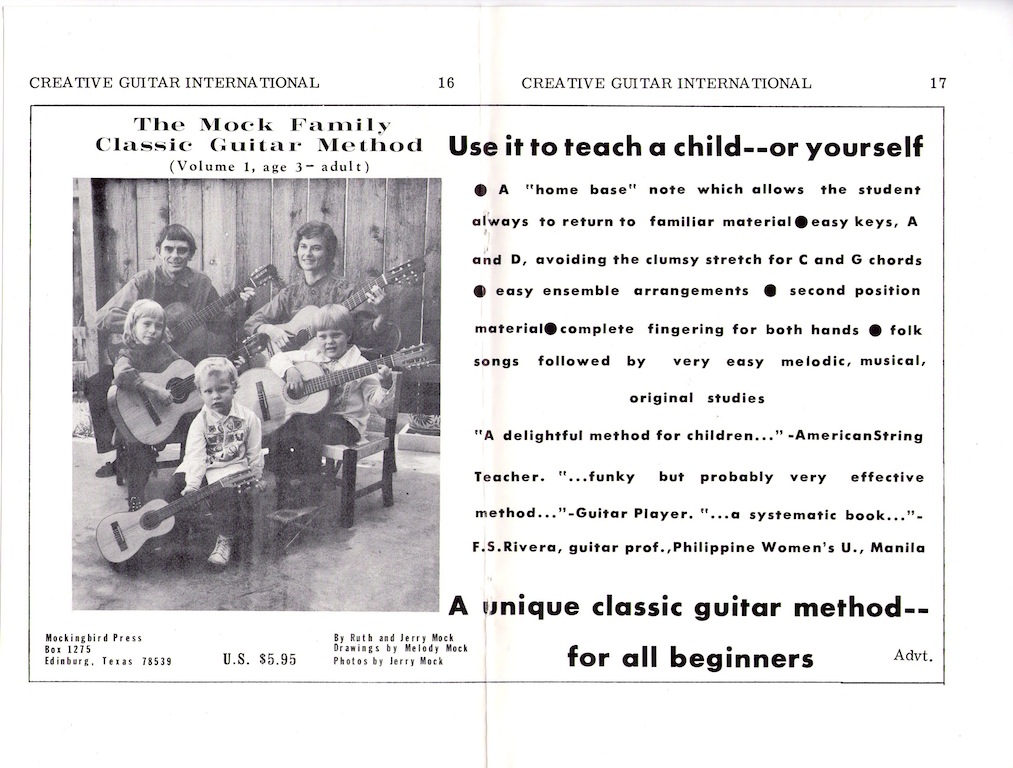
|
|
|||||
|
CREATIVE GUITAR INTERNATIONAL
|
18
|
CREATIVE GUITAR INTERNATIONAL
|
19
|
||
|
|
|||||
|
older brother, but this seldom works out, because the brother cannot discipline a younger child to such an extent. I solicit the help of the parent because I do not see the child every day. The parent does see his child daily and is really the "home teacher."
TRIES TO TAKE GUITAR FROM CHILD
Sometimes mothers are too overbearing and want to steal the lesson from the small child. One mother in her anxiety to "try it" often tried to take the guitar away from the child, and the boy became frustrated. I then put another guitar in her hands and she learned the more difficult accompaniments to the melodies. I gear the lesson to the level of the child. Sometimes the parent schedules additional time for herself ona more advanced level.
One child will accept parental help while another may be in the stage of asserting his independence. One ten-year-old resented his mother helping him count a complicated 6/8 rhythm. He was playing the guitar part to a Boccherini quintet and could play the notes, but could not count. Another boy, about two years older, who observed the situation, remarked that he WANTED HIS MOTHER TO HELP HIM COUNT! Neither mother could play the guitar, but both knew how to count, so the problem was solved by having the older boy's mother count for both of the boys.
REFUSE TO TEACH OWN CHILDREN
Unfortunately many guitarists refuse to teach their own children. I find that the guitarist parent often lacks confidence in his own method of teaching. He simply does not know how to begin. The Mock Family Classic Guitar Method was written for our children and for all begin-
|
ners, including adults. Each right hand finger is given a particular string to play with short finger movements. For example:
|
||||
 |
|||||
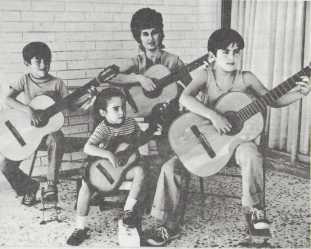 |
|||||
|
MRS. BERTA RAMON WITH JOE (RIGHT), JAIME AND DINA, PLAYING A VILLANCICO IN THE PATIO OF THEIR HOME IN EDINBURG, TX. MRS. RAMON ATTENDS EACH LESSON AND TEACHES EACH CHILD AT HOME, OFTEN TAPE RECORDING THE ASSIGNMENT.
|
|||||
|
|
|||||
|
|
|||||
|
CREATIVE GUITAR INTERNATIONAL
|
20
|
CREATIVE GUITAR INTERNATIONAL
"El Baliana" (first three measures only) |
21
|
||
|
The thumb is used on the three bass notes and a three-year-old can play the bass line of a song for a little guitar orchestra concert. Familiar songs follow, with the melody taught first. I find that the beginner has a difficult time stretching to the C or G chords. Therefore, a single line with the top three strings is quite enough. The left hand fingers play around a home base: This home base is held down while the other fingers workaround that note. This is the basis for the D and A chords, too. Simple accompaniments and variations make duos and trios available for the classroom or for the parent and child. This follows with the use of the rest stroke on the melody:
 |
|||||
|
|
|||||
|
© 1972 by Ruth and Jerry Mock |
|||||
 |
|||||
|
applies to the daily practice of the guitar. Our family practices before school in the morning because that seems to be the best time for us. Fortunately for me, my husband is also a guitarist so the responsibility is shared, lie teaches one child while I teach the other. The five-year-old and the seven-year-old each play an instrument besides the classic guitar--one the cello and the other the violin. Each lesson is no longer than 30 minutes, and that takes care of the practice for the day.
HALF HOURS ADD UP
People remark to me how "talented" our children are, but I think of it more in terms of daily practice. Those half hours really add up. My three-year-old's lessons range from five minutes to about fifteen. He will perform marvelously to get a bright colored star next to the line he plays! Although children his age learn by rote, he likes
|
|||||
|
The back of the Mock Family Method includes original material, each with a particular technical guitar problem such as the slur, or bar. For example, "El Baliana" is based on the simplified three chords of e minor, a minor and B. The song is musical and written guitaristically for the beginner. (See example, page 21).
Besides not knowing how to begin, the guitarist parent often feels he is more patient with other people's children than with his own. This may be true, especially when we expect too much from our own children. The same discipline that applies to eating and getting to school on time
|
|||||
|
|
|||||
|
|
||||||
|
CREATIVE GUITAR INTERNATIONAL
|
22
|
CREATIVE GUITAR INTERNATIONAL research will eventually reach the guitarist.
|
23
|
|||
|
to look at the "music." The pictures in the Mock Family Method help him find the song he wants to play.
CHILDREN NEED PICTURES
Children need pictures, drawings and large notes which are readily available in the Mock Method. The adult and parent can refer to the photographs of the right hand position which are essential for the production of sound and speed.
QUESTIONS AND SOLUTIONS
I welcome questions and solutions you have found. I am writing from the standpoint of the private studio teacher on a "one-to-one" basis. I have taught in classes, but over a period of years, find that my teaching is much more effective and enduring when the parent is involved. For some schools, music store studios or class teachers, it may seem impossible. But I recommend you give it a try if you can.
BY RUTH MOCK (Editor's note--In the next issue there will be a listing of teaching materials used by Ruth Mock in addition to the Mock Family Classic Guitar Method, Vol. 1. Since she was 12, Mrs. Mock has played in symphony orchestras and taught applied music in New York; Cairo, Egypt; Mexico and currently in South Texas. She received a masters degree in music at Florida State University.)
Contemporary concerto
Research about the guitar seems to be gathering momentum, and hopefully, the effects of some of this
|
||||||
|
For instance, Dr. Loris Chobanian wrote a concerto for guitar and orchestra to complete his PhD at Michigan State University in 1970. It was Chobanian's intention to look into the sound possibilities of
|
||||||
|
the guitar playing with a symphony orchestra. The composition is in contemporary idioms, without key, and with a twelve-tone row designed
|
Research
Contributing editor FRANK WAGNER
|
|||||
|
to accommodate guitar tuning.
|
||||||
|
Such a project tends to advance music for the guitar. Guitar music, like other music, cannot stand still. New music and new ideas for music need exploration. We think new ideas need to be exposed to the sunlight, rather than gather dust in a university library. "Creative Guitar International" will continue to review research materials and invites submission of research results for recognition and/or review.
THEORIES JOSTLED
Another development in 1970 was a dissertation for Yale by Dr. Thomas Heck which jostled theories about the origins of the guitar and attempted to establish that the six-string, classic guitar developed in Italy. Previous articles indicated the six-string, classic guitar developed in Spain or Germany. Heck received backing for his research from the Fulbright Commission and Yale University.
Portions of the Heck manuscript read like the makings of an exciting historical novel. He wrote of eventful times,
|
||||||
|
|
||||||
|
|
|||||
|
CREATIVE GUITAR INTERNATIONAL
|
24
|
CREATIVE GUITAR INTERNATIONAL
|
25
|
||
|
|
|||||
|
of 1805, for instance, when the devastation of areas of Italy such as Naples by the Napoleonic wars forced many, including musician, to flee to Vienna. So it was that Vienna, a city of 60,484 including suburbs, could support 20 operas in 1805. One would be hard put to visualize an American city of 60,000 supporting 20 operas in one year. But refugees filled Vienna and furnished the talent for much musical activity, including that of the guitar. Among them was Mauro Guiliani, the subject of the Heck dissertation. Dr. Heck pursued the Guiliani story at length and his research enriched his respect for the Italian guitarist and his compositions.
GUITAR DEVELOPMENT
The Heck dissertation contains a collection of facts and conjectures on the development of the guitar during the classical period. The work seems to define the state of guitar research concerning the period. Hopefully, someone will follow upon some of Heck's pioneering work and prove or disprove some of his assertions. The second of the two volumes includes a thematic catalogue of Guiliani's works, a significant contribution in itself. BY FRANK WAGNER Guitar with cello
Guitar and cello is an unusual instrumental combination seldom seen. An exception is the duo of guitarist Lisa Hurlong and her husband, cellist Stephen Kates.
The cello-guitar combination has certain hidden potentials, as well as hidden pitfalls. The two instruments are
|
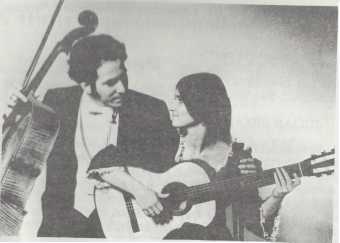 |
||||
|
THE KATES IN UNUSUAL INSTRUMENTAL PAIRING
nearly identical in range. Although this tends to make the two compatable, it also poses problems in arranging. Both instruments tend toward the same register, so that special care must be taken in arranging. The Kates have found ways to make the two instruments more compatable in regard tovolumeof sound. In a November 1972 concert In Wllmlngtin, DE, Kates used a mute to balance his instrument with the guitar.
Repertoire also Is a factor. Here are some numbers from their repertoire sent to "Creative Guitar International" by Mrs. Kates: An aria from a J.S. Bach pastoral in F for organ; "Bachianas Brasileiras No, 5" by Villa-Lobos, with Kates playing the voice melody and Mrs. Kates the guitar accompaniment; "Grosse Sonata" by Guiliani; "Four Popular Songs" by de Falla; "Dolente Immagnie
|
|||||
|
|
|||||
|
|
|||||
|
CREATIVE GUITAR INTERNATIONAL
|
26
|
CREATIVE GUITAR INTERNATIONAL 27
|
|||
|
|
|||||
|
Di Fille Mia" by Bellini; a sonata by Marcello; and "Sonata in d Minor" by Vivaldi.
|
A Hollywood composition
Jamei Stewart is a guitarist who does recording work in the Hollywood studios, mainly motion pictures, dramatic television shows and commercials. He is a specialist in all fretted instruments and styles.
Among Stewart's interests are the classic guitar and composition. He studied film composition with Albert Harris in the Los Angeles area and his next objective is to compare and orchestrate for film work. He wrote "Creative Guitar International" that:
"I started playing classic guitar at 14 years of age and I became aware of the instrument through my teacher Paul Miller. I studied with George M. Smith and studied also with a delightful teacher--Richard Pick who further kindled my interest in composition. Both George and Richard are excellent composers for the classic guitar."
Stewart's column on the classic guitar stands out from the usual rock, country, blues articles in the magazine "Guitar Player." A brief biography of a well known guitar composer of the past, along with a musical tribute to that composer, both by Stewart, appears in the magazine.
A composition "Homage de Francesco Tarrega" by Stewart in the January/February 1973 issue caught the eye of Jerry Mock "Creative Guitar international" editor. It was Variation I from the 2nd movement of
|
||||
|
|
|||||
|
The Kates have performed
|
Performance
|
||||
|
as a team in Mexico, and she has been guitar soloist in Kalmar, Sweden; Hungary; and Puerto Rico.
JULIAN BREAM
Pam Lipscomb, Austin, TX guitarist, sent us a program of an enterprising performance there by Britisher Julian Bream on the lute for the first half and guitar on the second. Research is making more renaissance music available for guitar, for the industrious guitarist. Or do we have other guitarists who double on lute? Perhaps one of our readers can compare the techniques of the two instruments.
DOUGLAS RICE
Douglas Rice sent us two unusual programs. One was a faculty recital by him of contemporary guitar music July 24 at the Cornish School of Allied Arts, Seattle, WA. The music was by Villa-Lobos, Lockrem Johnson and Rice.
The second program, given May 19 at Seattle, was by students of Rice and included group performances of works by Vivaldi and Mompou, and the permier performance of "Sonata Concertante for Flute and Guitar" by Rice, with George Thurtle on flute and Mary Thurtle on guitar.
The students were assisted by a string quartet, the flute, oboe, saxophone and harpsichord. The group performances were transcribed for guitars and other instruments by Rice.
|
|||||
|
|
|||||
|
|||||||||||||||||||||||||||||||||||||||||||||||||||||||||||||||||||||||||||||||||||||||||
|
|
|||||
|
CREATIVE GUITAR INTERNATIONAL
|
30
|
CREATIVE GUITAR INTERNATIONAL
|
31
|
||
|
|
|||||
|
The corporation will receive music collections and set up an archive to handle these collections and make copies of music. The ASTA group also will publish a newsletter. Marteen Lee Poort will edit the newsletter.
WORKSHOPS The Rev. Daniel A. Creagan reports plans are under way for the fourth annual master class at Spring Hill College, Mobile, AL, June 10 under Manuel Lopez Ramos. Lopez Ramos performed in Mobile during the last workshop, as did the duo of Maricarmen Costero and Mario Beltran. The duo also performed inEdinburg, TX, and New Orleans. A story is planned on 1974 summer workshops and "Creative Guitar International" invites news of these events.
|
(continued from page 2)"dentist who loves the classic guitar."
"We need some honest reporting, "wrote C. Lynn Brown, guitarist-teacher of Washington, MI. Earlier Brown wrote "...you have another subscriber, sight unseen." He added, "You need a section on contemporary teaching materials with suggestions for solving the problems. .. let's let the trash go and quit using it."
QUALITY MAGAZINE SOUGHT
Under suggestions, Grete F. Dollitz of Richmond, VA, wrote: "To become a magazine of the calibre available to piano teachers such as "Clavier." Mrs. Dollitz has a weekly radio program featuring the guitar.
Vaughn Aandahl, Denver, CO, wrote and directs a four-year degree program in classic guitar at Metropolitan State College, Denver. Aandahl wrote "Have you considered assuming the role of "Guitar News?"
(Editor's note: We began with the notice that the English publication "Guitar News" folded after publishing issue No. 119. We felt this vacuum should be filled.
(Unfortunately, "Guitar News" folded without advance
notice, leaving no way to contact its subscribers.
Mrs. Kay Appleby, business manager of "Guitar News" wrote us: "We have decided not to help anyone setting up
a follow-up magazine in the matter of giving names and
addresses of our members nor any other help. " She added:
"We wish you luck but do not think that anyone can make money out of a guitar magazine. " We would like to appeal
|
||||
|
|
|||||
|
|
||
|
CREATIVE GUITAR INTERNATIONAL 32
|
||
|
|
||
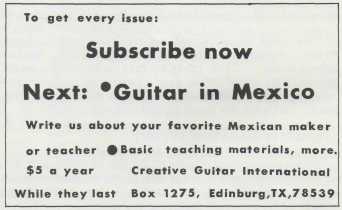 |
||
|
|
||
|
to our readers to pass on word to any known former subscriber of "Guitar News" that help has arrived. At Aandahl's suggestion, we again wrote Mrs. Appleby in August but had received no reply by Oct. 1. Any suggestions ?)
Jim Powell, guitar teacher of Oklahoma City writes: "I am pleased to see someone attempt a guitar magazine in this part of the country. One would think that New York City is the only place competent guitarists live..."
FILL REAL VOID
The Rev. Daniel A. Creagan, guitarist-teacher, chairman of the Fine Arts Department and professor of Art History, Spring Hill College, Mobile, AL: "I am sure guitarists the world over are eagerly looking forward to your publication. It will fill a real void. "
|
||
|
|
||